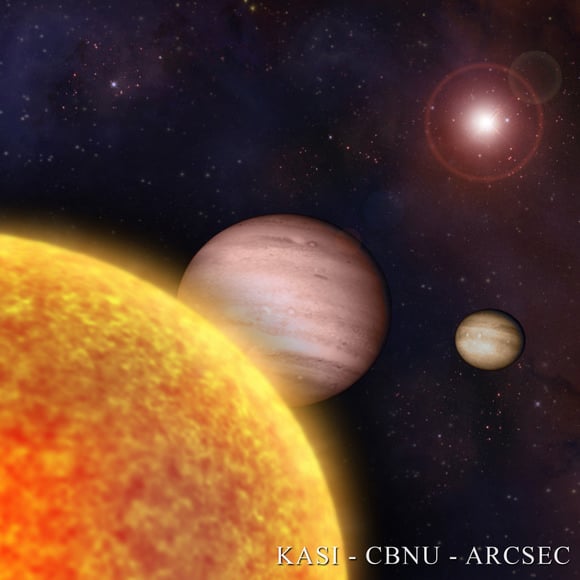[/caption] Planet hunters from the UK have discovered the largest exoplanet yet, and its uniqueness doesn't end there. Dubbed WASP-17, this extra large world is twice the size of Jupiter but is super-lightweight, "as dense as expanded polystyrene" one astronomer said. Plus it is going the wrong way around its home sun, making it the first exoplanet known to have a retrograde orbit. As a likely a victim of planetary billiards, astronomers say this unusual planet casts new light on how planetary systems form and evolve.
Astronomers say the planet must have flipped direction after a near miss with another huge "big brother" planet swung it around like a slingshot. "Newly formed solar systems can be violent places," said graduate student David Anderson, of Keele University. "Our own moon is thought to have been created when a Mars-sized planet collided with the recently formed Earth and threw up a cloud of debris that turned into the moon. A near collision during the early, violent stage of this planetary system could well have caused a gravitational slingshot, flinging WASP-17 into its backwards orbit." [caption id="attachment_37310" align="aligncenter" width="249" caption="An artist's impression of a transiting exoplanet. Credit: ESA C Carreau"]
[/caption] Though it is only half the mass of Jupiter it is bloated to nearly twice Jupiter's size.
Astronomers have long wondered why some extra-solar planets are far bigger than expected, and WASP-17 points to the explanation. Scattered into a highly elliptical, retrograde orbit, it would have been subjected to intense tides. Tidal compression and stretching would have heated the gas-giant planet to its current, hugely bloated extent. "This planet is only as dense as expanded polystyrene, seventy times less dense than the planet we're standing on", said Coel Hellier, also of Keele University.
WASP-17 is the 17th new exoplanet found by the Wide Area Search for Planets (WASP) consortium of UK universities. The WASP team detected the planet using an array of cameras that monitor hundreds of thousands of stars, searching for small dips in their light when a planet transits in front of them. Geneva Observatory then measured the mass of WASP-17, showing that it was the right mass to be a planet. The WASP-South camera array that led to the discovery of WASP-17 is hosted by the South African Astronomical Observatory.
Read the team's paper here.
Source: STFC
 Universe Today
Universe Today
